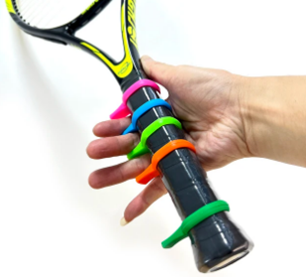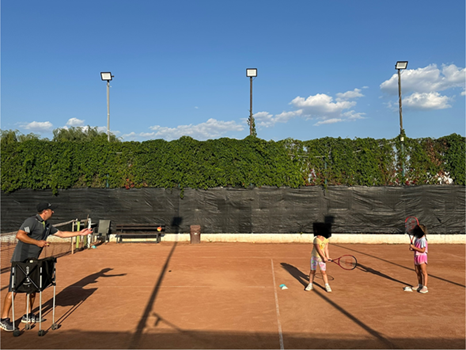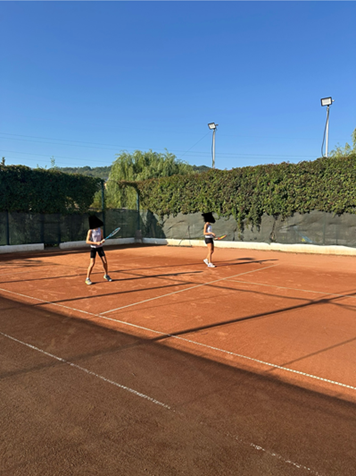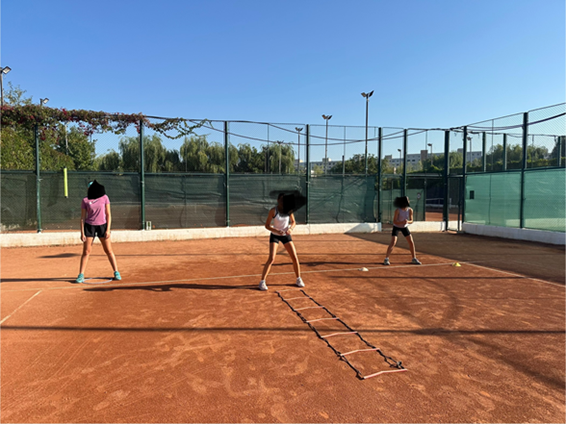Review article
PARTICULARITIES OF TECHNICAL AND TACTICAL TRAINING AT THE LEVEL OF JUNIORS IN TENNIS: A BRIEF REVIEW
Alexandru-Ilie Tudurachea*, Adrian Cojocariua
a”Alexandru Ioan Cuza” University Iași, Doctoral School in the Science of Sports and Physical Education, Str. Toma Cozma, nr. 3, Iași 700554, Romania
* Corresponding author. Tel.: +40726478277
E-mail address: tudurachealexandru@yahoo.com
Abstract
In lawn tennis, as in other sports games, performance factors are interdependent and mutually conditioning. Modern tennis requires a highly refined game technique, which can only be achieved through sustained, long-term skill acquisition. This technique must be developed in close correlation with the tactical mindset, since without this synergy, attaining higher performance levels would not be possible. Given that technical execution plays a decisive role in tennis, during periods when training focuses exclusively on physical conditioning, the level of technical proficiency tends to decline, which may compromise overall game quality. In sports involving simpler motor executions, based primarily on natural movements, the return of technical skill to its previous level can be achieved relatively quickly, often requiring just a few practice sessions. By contrast, in tennis, due to the finesse, complexity, and specificity of the technique, regaining prior technical level requires a substantially higher volume of training. At the onset of the training process, physical preparation acts as a supportive “belt” around the technical–tactical core. It is developed in alignment with this core, serving the purpose of accelerating learning and improving the efficiency coefficient of technical and tactical actions. The purpose of this article is to outline the fundamental principles of technical and tactical training in tennis, with a focus on their application across the various stages of junior athlete development.
Keywords: tennis game, technical and tactical training, juniors, performance, practice
-
Introduction
In performance tennis, success depends on the efficient integration of technique, tactics, physical conditioning, and mental training. A solid technique, acquired through systematic training, enables the player to execute strokes with precision and efficiency, while adequate tactical preparation allows for quick adaptation to the opponent’s playing style. This article aims to present the core principles of technical and tactical tennis training and examine their implementation across the distinct stages of junior player development (Kovacs et al., 2015).
In tennis, the primary performance factors are:
- Technical preparation – This is considered fundamental at the junior level.
- Tactical preparation – This factor must be incorporated into junior training proportionally to the technical repertoire acquired over time.
- Physical preparation – Although the primary focus for juniors should be on building a correct technical foundation, the development of motor abilities must also be at a sufficiently high level so as not to hinder the intensive work required for learning technique.
- Psychological preparation – This factor gains greater importance as the junior advances through the competitive system.
- Theoretical preparation – Theoretical knowledge is crucial for the athlete to understand the “puzzle” of training, which must be supported and directed along several directions (Woodward, 2011).
The more refined and biomechanically consistent the technique, the more efficient and economical a player becomes. For example, less energy is consumed when players achieve efficient court movement techniques. It is worth noting that advanced players are more economical in their style, thus consuming 20–30% less oxygen compared to beginners. The relationship between technical proficiency and movement efficiency is a critical observation that applies to all sports. Athletes must constantly make efforts to maximise their technical competencies and, consequently, should incorporate technical training as a core element of their overall training plan (Bompa, 2021).
Technique is developed progressively, beginning with simple technical skills. Once the athlete has mastered these fundamentals, the coach adapts and increases the complexity of the exercises by adding more technically demanding elements. Variations in technical execution are common and may result from the complexity of the task, as well as from the biomechanical or physiological traits of individual players. Acyclic sports, such as tennis, provide greater potential for technical variations (Bompa, 2021).
The goal of this article is to outline the primary aspects of technical and tactical training specific to tennis regarding the different stages of junior sport.
-
Main text
One element that makes a difference between various sports activities is the required technique. It encompasses all movement patterns, motor skills, and technical elements necessary for practising a specific type of sport. Technique may be defined as the manner of executing a motor skill or a physical exercise (Teodorescu, 2009). In our view, in tennis, players must constantly strive to attain a technique as close to perfection as possible in order to achieve the most efficient movement patterns. We maintain that not all methods are equally helpful for all athletes. For instance, a beginner tennis player will use a simplified technique compared to a world-class player. Consequently, when introducing technical elements into a player’s training schedule, the coach must be aware of the athlete’s individual level of development, as well as their technical strengths and weaknesses at that given moment.
When the physical capacity of athletes suffers a decline, technique also deteriorates. Likewise, high levels of fatigue negatively impact an athlete’s technical performance and their ability to refine their technique further. Generally, elevated fatigue levels are strongly correlated with lower work capacity. Therefore, when work capacity returns to normal or fatigue is controlled, players can restore their technique. Due to the adverse effects of fatigue on technical development, various specialists recommend that technical training sessions should take place before conditioning sessions and that a high-intensity physical training day should not precede a day dedicated to technical preparation (Bompa, 2021).
Technical learning is a process in which the player acquires a motor skill, refines it, and then assimilates it. An athlete’s ability to develop new motor skills depends on multiple factors, such as their current technical level and the complexity of the targeted skills. A player’s physical characteristics and physical development stage have a direct impact on their ability to acquire new skills. Nonetheless, factors such as individual learning style and the coaching methods employed during training also play an important role in determining the rhythm of skill acquisition. Therefore, it is the coach’s responsibility to select optimal learning methods based on specific training contexts (Muhammad & Abbood, 2020).
Learning a new set of motor skills is a process comprising three stages, which often cannot be separated into distinct phases, as they frequently overlap. In the first phase, athletes receive a detailed explanation of the skill and observe it being executed. After the initial explanation and demonstration, athletes begin to develop the general technical aspects of the skill, focusing on the key elements of the movement pattern. In the subsequent phase, players start to refine their skills; this process is long-term and requires numerous repetitions. During this stage, technical errors are constantly addressed, and athletes seek to improve the movement model while minimising or eliminating technical flaws. In the third stage of the learning process, players begin to consolidate the movement pattern, allowing the skill to become automated and executed naturally. This phase requires a substantial number of practical repetitions over an extended period. Nowadays, in learning tennis-specific technique, direct observation and verbal feedback are not the only underlying factors; instead, there is a strong integration of technological tools (e.g., ball-feeding robots, shot-tracking software, devices measuring stroke velocity, etc.) to support the learning process (Blessing, 2025).
An essential component of technical training is warm-up. To maximise performance in both training and competitive contexts, it is recommended that elite junior tennis players adopt dynamic warm-up protocols rather than traditional ones (Ayala et al., 2016).
Proper warm-up is a critical factor for optimising performance in elite sports. In tennis, where physical demands are highly varied and intense, selecting an efficient warm-up method is crucial. Several warm-up protocols are used to improve neuromuscular performance. However, there is limited scientific evidence as to which strategies are most effective for performance athletes (López-Samanes et al., 2021).
A 2020 study examining the performance-enhancing effects of a neuromuscular warm-up compared to a dynamic warm-up in junior players recommended including a relatively short (20–35 minutes) neuromuscular routine combining general mobility drills, trunk and shoulder strengthening exercises, and neuromuscular tasks (e.g., plyometrics, acceleration/deceleration, change-of-direction drills) to improve tennis-specific performance parameters (Fernandez-Fernandez et al., 2020).
Another study investigated and compared the post-activation potentiation effects of two warm-up strategies – dynamic stretching and high-load leg press – on physical qualities relevant to tennis performance. Results showed that dynamic stretching led to significant improvements in sprinting, agility, countermovement jump (CMJ), and hip flexion. At the same time, the high-load protocol negatively impacted sprint performance but improved agility, CMJ, and hip extension. Therefore, dynamic stretching brought higher benefits in sprint performance and hip mobility, with no significant differences between the two protocols for other variables. Consequently, dynamic stretching is recommended as a more effective warm-up strategy for elite tennis players preparing for immediate competition (Moreno-Pérez et al., 2019).
Findings by López-Samanes et al. (2021) further suggest that both dynamic warm-up and self-myofascial massage using a foam roller are effective in preparing tennis players for high-intensity activity. However, dynamic warm-up shows more significant positive effects on agility and quick directional changes. Therefore, to maximise elite athlete performance, dynamic exercises should be included in the precompetitive warm-up routine.
The technical and tactical components of training for junior tennis players are essential elements that require a well-structured, multidimensional approach. By implementing traiwoodning programmes that combine physical development, correct technique, and continuous performance assessment, coaches can support juniors in improving their ability to play effectively. This process impacts short-term performance and contributes to the development of successful competitive players.
In the following lines, we present the key elements specific to the different stages of junior tennis development, with a particular focus on the technical and tactical components:
- Age group 6–10 years old:
At this stage, coaches introduce players to basic stroke techniques, generally starting with the forehand, performed from a stationary position under simplified conditions. To practice this first stroke, players must learn the basic forehand grip. For this purpose, coaches may use markings on the racket grip or specially designed rackets to facilitate correct grip acquisition (Fig. 1).

Fig. 1. Racket designed for learning the correct grip (source: aliexpress.com)
The acquisition of the basic strokes (i.e., forehand, backhand, and serve) is carried out by following several methodological stages, which generally include: imitating the stroke, executing the stroke with a suspended ball, executing the stroke from a stationary position with a fed ball, executing the stroke from a stationary position with a tossed ball (Fig. 2), executing the stroke with slight movement, rallying on half court, executing the stroke under game-like conditions, and executing the stroke under increasingly varied conditions.

Fig. 2. Learning the backhand stroke – primary initiation stage
At this stage of junior development, an increasing number of coaches use the Tennis 10s method. This is the ITF (International Tennis Federation) component for players aged 10 and under, focused on increasing participation levels in tennis and providing more appropriate development pathways for young players, including more suitable competitions. This methodological approach, introduced in children’s training, is designed for players between the ages of 6 and 10 and was created specifically to meet their needs and abilities. For a 6-year-old child, everything on a standard tennis court may seem overwhelming – the racket feels too long and heavy, and the ball appears to “bounce away” too quickly. This is precisely why the Tennis 10s system was developed: to allow children to learn and play in an environment adapted to their level (Ciuntea, 2015).
For children aged 6–8, the use of the “red court” is recommended, measuring 11 meters in length and 5–6 meters in width. On this court, a red ball is used, which has 75% lower compression than a standard ball, made from a special fibre. It is ideal for beginners because it is soft to the touch and does not bounce too high (Ciuntea, 2015). According to this methodology, at 8–9 years of age, the “orange court” is used, measuring 18 meters in length and 6.5–8.2 meters in width. On this court, an orange ball is used, with 50% lower compression than a standard ball.
The green ball (25% lower compression than a standard ball) is very similar to the official competition ball, but slightly slower and with a lower bounce. The recommended age for its use is up to 10 years old, with the court measuring 23.77 meters in length and 8.23 meters in width. This methodology also recommends specific racket sizes according to the playing level: 41–58 cm for the red stage, 58–63 cm for the orange stage, and 63–68 cm for the green stage (Ciuntea, 2015).
From a tactical standpoint, during the 6–10 age stage, athletes learn how to cover the playing surface and create space on the opponent’s court.
From a motor development perspective, the development of general motor skills is one of the most critical aspects of overall athlete development between the ages of 6 and 10. It is a complex process requiring several cortical areas (i.e., sensory, motor, and association areas), which are the basis for coordinating the neuromusculoskeletal functions involved in all precise movements. At this stage, significant progress has been made in the sensitivity of all sensory organs, along with anthropometric growth, with a slight advantage for boys. The need for movement is essential, as it provides children with the means to practice newly acquired motor skills while satisfying their curiosity and need for exploration. Children love games, which is the most crucial factor in instruction and in forming motor competencies (Ardelean, 2014).
- Age group 10–14 years old:
In this stage, coaches prioritise correlating the basic elements of on-court movement and acquiring technically correct strokes. In the first phase of the stage, a transition is made from modified play to play on the standard court. Over time, players acquire advanced skills in positioning, ball striking, and weight transfer, enabling them to adapt to every game situation. As the technical and tactical repertoire expands, technical procedures are practised under increasingly varied conditions.
From a tactical point of view, players learn to make decisions based on the opponent’s actions. During this stage, players are also introduced to doubles game (Fig. 3) tactics (Woodward, 2011).

Fig. 3. Doubles game tactics differ considerably from those used in singles play.
From a somatic perspective, this stage is characterised by an acceleration in height growth, which increases on average by 4–6 cm per year. During this stage, body weight increases by an average of 3 to 5 kg per year. The upper and lower limbs, as well as the trunk, undergo significant elongation, temporarily disturbing body proportions and creating a transient imbalance in physical appearance. Functionally, a decline in work capacity may be observed, primarily due to the incomplete maturation of the lungs, heart, and vascular system. Physical exercise leads to intensified circulation and a slight increase in blood pressure, caused by the additional effort required from the heart and the respiratory system, which are not yet fully developed (Ardelean, 2014).
- Age group 14–18 years old:
In this stage, emphasis is placed on practising technical procedures under increasingly varied conditions and at the highest possible velocities. Technical refinement is a fundamental objective for any player aiming for high-level performance. From a tactical perspective, match play can be planned according to the opponent’s specific characteristics.
Regarding physical training, during the 14–18 age stage, training periodisation and individualisation are introduced (Fig. 4). During this period, successful execution requires not only technical skills but also adequate physical preparation, including strength, agility, and flexibility (Fu et al., 2018). The application of strength and conditioning protocols targeting the muscle groups involved in stroke execution is essential for performance improvement and is feasible during this age range (Fernández-Fernández et al., 2016).
Research highlights that incorporating sports physical training can increase both the speed and accuracy of technical execution by developing muscular strength and endurance in the relevant areas (Kara et al., 2015). Coaches are encouraged to integrate these conditioning methods alongside technical skill development to produce complete athletes capable of performing effectively under high-pressure, competitive conditions (Myers et al., 2016).
The study conducted by Ali and Supriono (2021) analysed the impact of physical fitness on technical efficiency in tennis, using a sample of 15 male players from Jambi. Several key physical components were assessed, including arm strength, back flexibility, and hand–eye coordination, using standardised tests. The study concludes that good physical conditioning is essential for effective technique and recommends that training should combine technical skill development with specific physical exercises to improve the competitive performance of players. According to Fett et al., the demands of modern tennis have transformed this sport into an increasingly explosive game, requiring young athletes to refine their technique at high speeds to withstand competitive pressures (Fett et al., 2020). This growing intensity underscores the need for targeted training to improve ball speed and stroke precision.

Fig. 4. After the age of 14, physical training becomes a decisive factor in differentiating players on the court.
Physical training is a vital aspect in the pursuit of performance. Specific strength exercises have been shown to improve stroke velocity, with some studies reporting a significant increase in speed following a six-week programme focused on strength training. This programme included core strengthening exercises and the use of medicine balls, resulting in a 4.9% increase in stroke velocity among juniors (Kara et al., 2015).
In addition to physical aspects, mental elements such as focus and adaptability during play are essential for junior players at this stage. Tactical awareness – including ball placement and service strategy – significantly influences performance. For instance, employing methods such as serving to the opponent’s weaker side can be more effective when players understand the dynamics of constructing a point (Fernández-Fernández et al., 2020).
At this age, we recommend utilising mental training sessions and collaborating with specialists in the field, as the development of psychological and cognitive abilities plays a crucial role in on-court performance. Predoiu et al. (2020) have reported that tests such as reaction time, intersegmental coordination, and hand–eye coordination are valuable tools for identifying aspects that can be improved through specific training. These tests enable the creation of a performance profile, which, if continuously monitored, helps adapt training interventions. This complementary strategy is also suggested by Fernández-Fernández et al. (2014), who emphasise the value of regular physical testing in determining individual needs.
3. Conclusions
Technical training plays a crucial role in junior tennis, thus laying the foundation for performance development and being closely intertwined with tactical, physical, and psychological growth. Technical mastery follows a progressive, step-by-step process, shaped by the motor development of athletes and the continuity of training. Modern technology and dynamic warm-up techniques significantly enhance the efficiency of training sessions. Adjusting technical drills to the players’ age and skill level is essential for consistent progress in this sport.
Competitive tennis demands a multi-layer combination of physical, psychomotor, and psychological qualities. Reaction speed, coordination, explosive power, focus, and a genuine passion for the sport are key factors of success. Early talent identification, ideally starting around ages 6–7, is recommended to maximise their potential, after considering heredity and the child’s developmental profile. The synergy between innate abilities and well-structured training provides a solid framework for achieving outstanding tennis performance.
For younger players (ages 6–10), the Tennis 10s programme offers a practical methodological framework, adapting equipment and court dimensions to children’s abilities. The use of smaller courts, modified rackets, and low-compression balls makes the game more accessible, engaging, and easier to learn. In the subsequent stage (ages 10–14), the focus shifts to improving basic movement patterns and developing technically accurate strokes, which are the primary objectives of coaches. The final stage of junior training, as athletes approach 18 years of age, centres on perfecting techniques while integrating structured physical training, ultimately aimed at optimising performance in official competitions.
4. References
Ali, M., & Supriono, S. (2021). Profile of the physical condition of the determinant of the serve and skills on the court tennis service. Jurnal SPORTIF: Jurnal Penelitian Pembelajaran, 7(2), 258-269. https://doi.org/10.29407/js_unpgri.v7i2.16385
Ardelean, D. (2014). Contribuții privind rolul jocului de handbal asupra dezvoltării bio-psiho-motrice a copiilor la vârsta de 8–10 ani [Teză de doctorat, Universitatea Națională de Educație Fizică și Sport]. București.
Ayala, F., Moreno-Pérez, V., Vera-García, F. J., Moya, M., Sanz-Rivas, D., & Fernández-Fernández, J. (2016). Acute and time-course effects of traditional and dynamic warm-up routines in young elite junior tennis players. PLOS ONE, 11(4), e0152790. https://doi.org/10.1371/journal.pone.0152790
Blessing, M. (2025). Optimizing tennis training strategies using cloud-based models [Doctoral dissertation, Obafemi Awolowo University].
Bompa, T. O. (2021). Periodizarea: teoria și metodologia antrenamentului. Centrul Național de Formare și Perfecționare a Antrenorilor.
Ciuntea, M. L. (2015). Impactul Tenis 10 asupra dezvoltării calităților motrice [Teză de doctorat, Universitatea Națională de Educație Fizică și Sport]. București.
Fernandez-Fernandez, J., Ulbricht, A., & Ferrauti, A. (2014). Fitness testing of tennis players: How valuable is it? British Journal of Sports Medicine, 48(Suppl 1), i22–i31. https://doi.org/10.1136/bjsports-2013-093152
Fernandez-Fernandez, J., De Villarreal, E. S., Sanz-Rivas, D., & Moya, M. (2016). The effects of 8-week plyometric training on physical performance in young tennis players. Pediatric exercise science, 28(1), 77-86. https://doi.org/10.1123/pes.2015-0019
Fernández-Fernández, J., García-Tormo, V., Santos-Rosa, F. J., Teixeira, A. S., Nakamura, F. Y., Granacher, U., & Sanz-Rivas, D. (2020). The effect of a neuromuscular vs. dynamic warm-up on physical performance in young tennis players. Journal of Strength and Conditioning Research, 34(10), 2776–2784. DOI: 10.1519/JSC.0000000000003703
Fett, J., Ulbricht, A., & Ferrauti, A. (2020). Impact of physical performance and anthropometric characteristics on serve velocity in elite junior tennis players. The Journal of Strength & Conditioning Research, 34(1), 192-202. DOI: 10.1519/JSC.0000000000002641
Fu, M. C., Ellenbecker, T. S., Renstrom, P. A., Windler, G. S., & Dines, D. M. (2018). Epidemiology of injuries in tennis players. Current reviews in musculoskeletal medicine, 11, 1-5. https://doi.org/10.1007/s12178-018-9452-9
Kara, E., Aksit, T., Ozkol, M., & Isik, T. (2015). Effects of a 6-week tennis-specific exercises program on service velocity. Turkish Journal of Sport and Exercise, 17(1), 71–76. https://doi.org/10.15314/tjse.49317
Kovacs, M. S., Roetert, E. P., & Ellenbecker, T. S. (2015). Efficient deceleration: The forgotten factor in tennis-specific training. Strength & Conditioning Journal, 37(2), 92-103. DOI: 10.1519/SSC.0000000000000140
Lopez-Samanes, A., Del Coso, J., Hernández-Davó, J. L., Moreno-Pérez, D., Romero-Rodriguez, D., Madruga-Parera, M., … & Moreno-Pérez, V. (2021). Acute effects of dynamic versus foam rolling warm-up strategies on physical performance in elite tennis players. Biology of Sport, 38(4), 595-601. https://doi.org/10.5114/biolsport.2021.101604
Muhammad, Q., & Abbood, R. M. (2020). The effect of direct learning method according to the theory of the summons scheme in learning some basic tennis skills. International Journal of Psychosocial Rehabilitation, 24(1), 5839–5847. https://doi.org/10.37200/IJPR/V24I1/PR200684
Moreno-Pérez, V., López-Samanes, Á., Domínguez, R., Fernández-Elías, V. E., González-Frutos, P., Fernández-Ruiz, V., … & Fernández-Fernández, J. (2019). Acute effects of a single tennis match on passive shoulder rotation range of motion, isometric strength and serve speed in professional tennis players. PLOS ONE, 14(4), e0215015. https://doi.org/10.1371/journal.pone.0215015
Myers, N. (2016). A Biomechanically Based Observational Tennis Serve Analysis Method Can be Used to Assess Serve Mechanics. https://doi.org/10.13023/ETD.2017.006
Predoiu, R., PREDOIU, A., MITRACHE, G., FIRĂNESCU, M., COSMA, G., DINUŢĂ, G., & BUCUROIU, R. A. (2020). VISUALISATION TECHNIQUES IN SPORT-THE MENTAL ROAD MAP FOR SUCCESS. Discobolul-Physical Education, Sport & Kinetotherapy Journal, 59(3). https://doi.org/10.35189/dpeskj.2020.59.3.4
Teodorescu, S. (2009). Periodizare și planificare în sportul de performanță (Ed. rev. 2). Editura Alpha MDN.
Woodward, M. (2011). Badminton coach education: Coaches’ manual, Level 1. Badminton England.
